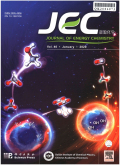- 钛学术文献服务平台 \
- 学术期刊 \
- 工业技术期刊 \
- 石油与天然气工业期刊 \
- 能源化学期刊 \
P(VDF-HFP)-poly(sulfur-1,3-diisopropenylbenzene) functional polymer electrolyte for lithium–sulfur batteries
P(VDF-HFP)-poly(sulfur-1,3-diisopropenylbenzene) functional polymer electrolyte for lithium–sulfur batteries
基本信息来源于合作网站,原文需代理用户跳转至来源网站获取
摘要:
Lithium–sulfur (Li–S) battery as a high-energy density electrochemical energy storage system has at-tracted many researchers' attention. However, the shuttle effect of Li–S batteries and the challenges associated with lithium metal anode caused poor cycle performance. In this work, the organosulfide poly(sulfur-1,3-diisopropenylbenzene) (PSD) was prepared as cathode material and additive of P(VDF-HFP) polymer electrolyte (P(VDF-HFP)). It was verified that P(VDF-HFP) polymer electrolyte with 10%PSD (P(VDF-HFP)-10%PSD) showed a higher ionic conductivities than that of liquid electrolyte up to 2.27 × 10- 3 S cm- 1 at room temperature. The quasi-solid-state Li- S batteries fabricated with organosul-fide cathode material PSD and P(VDF-HFP) based functional polymer electrolyte delivered good cycling stability (780 mAh g- 1 after 200th cycle at 0.1 C) and rate performance (613 mAh g- 1 at 1 C). The good cycling performance could be attributed to the synergistic effect of components, including the in-teraction between polysulfides and polymer main chain in the organosulfide cathode, the sustained or-ganic/inorganic hybrid stable SEI layer formed by polymer electrolyte additive PSD, the improved cath-ode/electrolyte interface and the good affinity between P(VDF-HFP) based functional polymer electrolyte and Li metal surface. This strategy herein may provide a new route to fabricate high-performance Li–S batteries through the organosulfide cathode and functional polymer electrolyte.

推荐文章
EVOH-SO3Li/P(VDF-HFP)/HAP锂离子电池隔膜的制备及电化学性能
锂离子电池隔膜
聚偏氟乙烯-六氟丙烯
EVOH-SO3Li
纳米羟基磷灰石
静电纺丝
Ag@MoS2/P(VDF-HFP)电介质复合材料的制备及性能研究
Ag纳米线
二硫化钼
核壳结构
复合材料
介电性能
基于静电纺丝和静电喷射技术的P(VDF-HFP)/Al2O3/P(VDF-HFP)复合隔膜的制备与电化学性能分析
锂离子电池
凝胶聚合物电解质
静电纺丝
静电雾化沉积
单向拉伸对P(VDF-HFP)膜结晶相、介电和储能特性的影响
P(VDF-HFP)
储能密度
介电性能
内容分析
关键词云
关键词热度
相关文献总数
(/次)
(/年)
引文网络
引文网络
二级参考文献 (0)
共引文献 (0)
参考文献 (0)
节点文献
引证文献 (0)
同被引文献 (0)
二级引证文献 (0)
2020(0)
- 参考文献(0)
- 二级参考文献(0)
- 引证文献(0)
- 二级引证文献(0)
引文网络交叉学科
相关学者/机构
期刊影响力
能源化学
主办单位:
中国科学院大连化学物理研究所
中国科学院成都有机化学研究所
出版周期:
双月刊
ISSN:
2095-4956
CN:
10-1287/O6
开本:
出版地:
大连市中山路457号
邮发代号:
创刊时间:
语种:
eng
出版文献量(篇)
2804
总下载数(次)
0
总被引数(次)
7996
期刊文献
相关文献
推荐文献
- 期刊分类
- 期刊(年)
- 期刊(期)
- 期刊推荐
一般工业技术
交通运输
军事科技
冶金工业
动力工程
化学工业
原子能技术
大学学报
建筑科学
无线电电子学与电信技术
机械与仪表工业
水利工程
环境科学与安全科学
电工技术
石油与天然气工业
矿业工程
自动化技术与计算机技术
航空航天
轻工业与手工业
金属学与金属工艺
能源化学2022
能源化学2021
能源化学2020
能源化学2019
能源化学2018
能源化学2017
能源化学2016
能源化学2015
能源化学2014
能源化学2013
能源化学2012
能源化学2011
能源化学2010
能源化学2009
能源化学2008
能源化学2007
能源化学2006
能源化学2005
能源化学2004
能源化学2003
能源化学2002
能源化学2001
能源化学2020年第9期
能源化学2020年第8期
能源化学2020年第7期
能源化学2020年第6期
能源化学2020年第5期
能源化学2020年第4期
能源化学2020年第3期
能源化学2020年第12期
能源化学2020年第11期
能源化学2020年第10期
能源化学2020年第1期

 免费查重
免费查重










